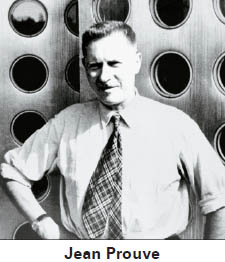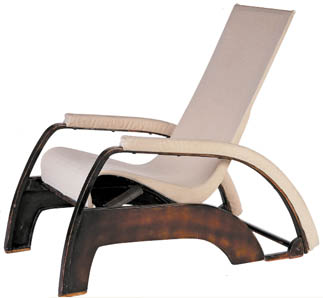Praise for the lowly chair

Believe it or not, though, some people actually praise the creation as a perfect piece of architecture, not just a place to put your tush.
Now, you can check out for yourself what chairs have to offer at a retrospective exhibition that starts Friday featuring the works of French architect and designer Jean Prouve (1901-1984).
To mark the 25th anniversary of his death, the Vitra Design Museum in Weil am Rhein, Germany, and the Daelim Contemporary Art Museum in central Seoul worked together to bring this rare exhibition, entitled “Jean Prouve: The Poetics of the Technical Object,” to town.

“Fauteuil de Grand Repos” by Jean Prouve, 1930. Provided by the museum
The recent vintage fad in the interior design industry here has shown the public that chairs can be more than just something that we sit on. It also helped highlight some famous chairs that were created by notable designers such as Swiss-French architect Le Corbusier (1887-1965), German architect Walter Gropius (1883-1969) and German-American architect Ludwig Mies van der Rohe (1886-1969), among others.
Earlier this year, an exhibition of furniture designed by the renowned American designer couple Charles (1907-1978) and Ray (1912-1988) Eames was held at the Seoul Arts Center, further reflecting the city’s increased interest in designer furniture.
While learning about the designers isn’t that difficult, nailing down the particular design styles is a bit harder. “Egg chairs” and “pelican chairs” aren’t as hard to grasp, as the names reflect the look of the pieces. But many are more esoteric.
Koreans may already be familiar with Prouve’s chairs. Most locals who attended school here sat on chairs that are strikingly similar to his Standard Chair, which embodies the designer’s philosophy of incorporating practicality and functionality. No one is sure how the chairs in Korean schools came to resemble Prouve’s designs.
But both are simple and humble, befitting of the educational atmosphere, as they support Korean students’ spines during those long class hours. Teachers even use them as a means of punishment, ordering some misbehaving kids to hold them above their heads for hours.
“Prouve’s designs have form, function and timeliness, the three basic elements in good design,” said Kim Myeong-hwan, the president of aA Design Museum, which has a range of vintage European and American furniture. “After World War I came industrialization, and steel was used in a variety of products. Prouve was the first to use bent, pressed and compressed sheet metal in furniture, enhancing the durability, lowering the weight and facilitating mass production.”
The exhibition at the Daelim museum runs from this Friday to Nov. 29. For more information, call (02) 720-0067 or check out www.daelimmuseum.org.
By Seo Jung-min [hkim@joongang.co.kr]










with the Korea JoongAng Daily
To write comments, please log in to one of the accounts.
Standards Board Policy (0/250자)